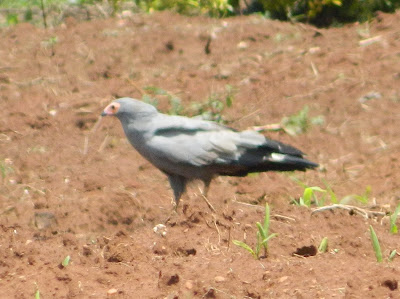 |
| Bateleur eagle (Terathopius ecaudatus) at rest in Murchison Falls National Park, Uganda |
Everyone can enjoy eagles, hawks, and falcons, otherwise known as birds of prey. Everyone, that is, except the prey. Sorry rodents, snakes, lizards, and smaller birds, this post celebrates your air-borne stalkers.
 |
| A male bateleur eagle in flight over Agahozo-Shalom Youth Village in Rwanda |
 |
| A Long-crested eagle (Lophaetus occipitalis) rests atop a big termite mound, about 5 km from where we live in Rwanda. |
Many birds hunt, catching insects or other invertebrates, but birds of prey are generally big aerial hunters. Nearly all of them take bigger animals, like reptiles, other birds, small mammals, or fish.
 |
| The Martial Eagle (Polematus bellicosus) is one of Africa's largest birds of prey. This adult bird rests in Serengeti National Park in Tanzania. |
 |
| Augur Buzzard, (Buteo augur), flying over Agahozo-Shalom Youth Village in Rwanda |
Bird of prey is a general phrase that can include several families of birds: Accipitridae (hawks, eagles, buzzurds, old world vultures), Falconidae (falcons, kestrels), Cathartidae (the new world vultures), the two families of owls, the Secretarybird (in a monotypic family, where it is the only member), and the osprey (also in a monotypic family). I am saving vultures for a separate post, have covered the Secretarybird already, only have one decent picture of an owl, and have not photographed osprey in Africa, so they are not covered here.
 |
| Great Sparrowhawks (Accipiter melanoleucus) occasionally visit ASYV. |
 |
| African Harrier Hawk (Polyboroides typus) in a recently cleared field at Agahozo-Shalom Youth Village in Rwanda |
 |
| African Harrier Hawk in flight at Agahozo-Shalom Youth Village in Rwanda |
Birds of prey have strong talons and can exert serious force when they grab. If you have even seen a falconer or bird of prey demonstration at a zoo, the handlers always have specialized gloves to prevent their arms from being torn and crushed. Their bills are sharp, down-curved hooks that can rip apart flesh. Birds of prey also have excellent eyesight that they use to scan for prey as they soar in the sky.
 |
| Is this Lizard Buzzard (Kaupifalco monogrammicus) eyeing me as a potential meal? Pictured near Mabamba Swamp, Uganda. |
 |
| Gabar Goshawks (Melierax gabar) visit ASYV in Rwanda from time to time. This bird gave a small student group excellent views on their first bird watching experience. Thanks, birdie! |
 |
| Southern Banded Snake-eagle (Circaetus fasciolatus) in Amani Rainforest, Tanzania. |
 |
| Western Banded Snake-eagle (Circaetus cinerascens) at the Entebbe Botanical Gardens, Uganda. |
 |
| The same Western Banded Snake-eagle in flight. |
 |
| A Black Kite (Milvus migrans) has a distinctive body shape that is easily recognized on the wing. |
 |
| The same kite as above, at the shore of Lake Kivu, Rwanda. |
All the previous pictures have been of birds in the family Accipitridae. The next three are in the family Falconidae. There are many structural differences between the two families, but they fill very similar ecological roles. Falcons, however, tend to be very fast and have longer, less broad wings.
 |
| This Lanner Falcon (Falco biarmicus) on the far left is being mobbed by Pied Crows. Groups of birds like crows and jays will harass birds of prey to drive them away. |
 |
| A pair of African Pygmy Falcons (Polihierax semitorquatus) in Tarangire National Park, Tanzania |
 |
| A Grey Kestrel (Falco ardosiaceus) outside of Murchison Falls National Park, Uganda. |
You can enjoy watching a bird of prey almost anywhere in the world. Red-tailed Hawks are one of the most common birds of prey in North America. They live in Manhattan (as city as it gets), are all over the countryside, and are even easily seen in the suburbs where I am from. But at the right times of year, in many parks, you can find other migrating or resident birds of prey. Keep your eyes out for your local little game hunters!




Very good blog.
ReplyDeleteJared, my wife and I are in Kigali adopting our daughter and I've got some good pics of several large birds around the b and b we are staying at. I don't know how to send them to you but you can check out our blog in a few days and I'll have them up. There is one close up of what I think is a great sparrow hawk attacking a long crested eagle, both are talons up maybe 6" from each other. Right across form our room, I just happened to be taking pics of the eagle when it happened.
ReplyDeleteBlog is louisvillelattas.blogspot.com
G
This is such an informative post. You have a lot of really great points. I wish I had this post as a resource when I started blogging.
ReplyDeletebird Watching Binoculars.